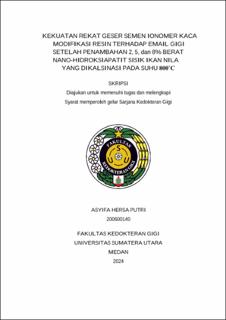| dc.description.abstract | Resin modified glass ionomer cement (RMGIC) is a dental restoration material that has good aesthetic and antibacterial restoration results, but there are shortcomings in its mechanical properties. To address shortcomings, and modified the material by adding nano-hydroxyapatite. Nano-hydroxyapatite can synthesized from natural materials such as tilapia scales (Oreochromis niloticus), which can enhance shearbond strength of RMGIC. The objective study is investigating difference in shearbond strength of RMGIC to tooth enamel after addition 2, 5, and 8% weight calcined tilapia scale nano-hydroxyapatite at 800°C and size reduction using top-down method with ball-mill. Forty samples were divided into 4 groups: group without addition and groups with addition 2, 5, and 8% weight of nano-hydroxyapatite. The samples RMGIC is tablet (diameter 4mm and thickness 2mm), bonded to palatal surface premolar teeth mounted in self- cured acrylic resin. The ratio (RMGIC:nano-hydroxyapatite:liquid) used groups 1, 2, 3, and 4 (0.160:0.000:0.050g; 0.157:0.003:0.050g; 0.152:0.008:0.050g;
0.147:0.013:0.50g). After homogenization, they placed into molds, covered with celluloid strips, and light-cured for 20 seconds. The samples immersed in distilled water for 24 hours. Shearbond strength tested using universal testing machine. The results showed mean and standard deviation groups 1, 2, 3, and 4 were 4.850±0.210MPa, 5.271±0.083MPa, 5.421±0.950MPa, and 5.910±0.609MPa.
Based on One-Way Anova test, there was significant difference in shearbond strength of RMGIC to tooth enamel after the addition nano-hydroxyapatite. It was concluded in research, there was significant difference in shearbond strength RMGIC to tooth enamel after addition 2, 5, and 8% weight of calcined tilapia fish scale nano-hydroxyapatite. | en_US |


